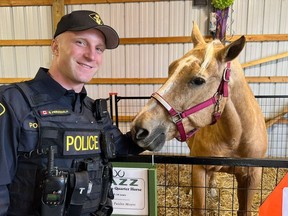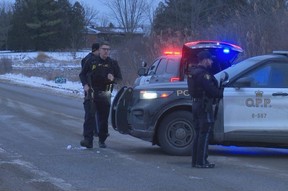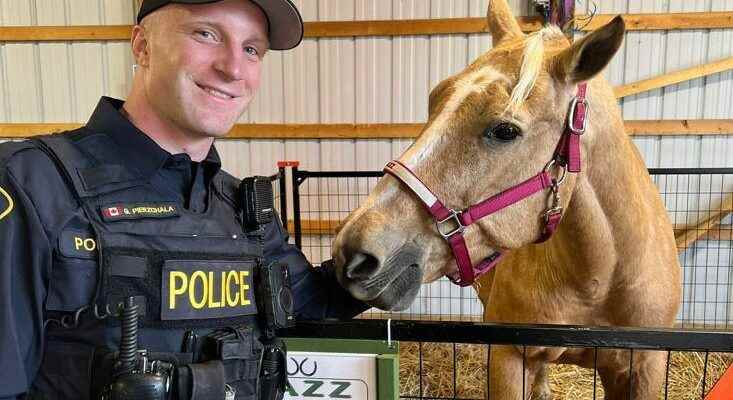Footage from the body camera of a slain OPP officer will be available to prosecutors for the trial of two people accused in his shooting death on a Southwestern Ontario road this week.

Footage from the body camera of a slain OPP officer will be available to prosecutors for the trial of two people accused in his shooting death on a Southwestern Ontario road this week.
const. Grzegorz (Greg) Pierzchala, 28, was fatally shot on Tuesday while responding to a vehicle in a ditch west of Hagersville.
The rookie officer, who had just passed his probation period on the day he died, was wearing a body camera, OPP Commissioner Thomas Carrique said at news conference Wednesday.
Haldimand County, where Pierzchala had been stationed for just over a year, became the first OPP detachment to outfit officers with body cameras since the spring of 2021 as part of a pilot project.
The footage from the fatal encounter — the first time a Canadian police officer equipped with a body camera has been killed — will be an important piece of evidence in court and will also serve as a valuable training resource for police, Western University sociologist Mike Arntfield said .
“It will certainly be what’s known as the best evidence in court. . . the most visceral and accurate approximation or replication of what happened,” said Arntfield, a former London police officer and author of several books on cold case killings.
Randall McKenzie, 25, of Kingston and Brandi Crystal Lyn Stewart-Sperry, 30, of Hamilton are charged with first-degree murder.

The former head of Ontario’s police watchdog said body-camera footage is “an invaluable truth-seeking tool” but much remains unknown about what the slain officer’s camera captured.
“The video camera has to be in the direction of the shooter and in this case we don’t know that,” said Ian Scott, who was director of the Special Investigations Unit from 2008 to 2013.
“But it would continue to run even after the (officer) was shot and could have valuable information there. If there is relevant footage, it could be absolutely, utterly compelling.”
Video footage is especially valuable in court, said Scott, who drew on surveillance footage to charge Toronto police C
onst. James Forcillo in the 2013 shooting death of Sammy Yatim, 18, on a Toronto street car.
Forcillo was convicted of attempted murder and perjury.
“It’s pretty hard to cross-examine a video, unlike witnesses,” Scott said. “You can’t push around (video) in a cross examination in terms of their perspective, whether they had alcohol or drugs in their system at the time.”
Arntfield said the footage will also be valuable for police training that is based on actual events.
“Rather than just concocting some implausible scenario, you draw on repository of previous tragedies and . . . the reality that there is no such thing as a routine call,” he said. “You train and condition officers to approach what seem to be benign situations with these earlier realities in mind.”
Pierzchala was shot and killed while responding to a call about a car in a ditch along Indian Line Road, just west of Hagersville, at about 2:40 pm Tuesday. The suspects allegedly robbed a citizen of their vehicle at the scene after shooting Pierzchala, who was “essentially ambushed,” and didn’t return fire, Carrique said.

The OPP didn’t respond to questions about the body-camera footage, but Carrique first mentioned it at the news conference Wednesday, saying the video will form part of the evidence that investigators are working with.
While police in the United States often release body-camera footage, Arntfield said that likely won’t be the case in this week’s shooting.
“Body-cam footage is often released in the US to exonerate or pre-emptively mitigate narratives about police malfeasance. In this case I don’t see the public interest in releasing the footage,” he said.
Hundreds of first responders and members of the public attended a
procession to pay tribute to Pierzchala
— the fourth police officer fatally shot since September in Ontario — on Friday. The procession carrying the officer’s body traveled from the coroner’s office in Toronto, where first responders lined up to salute the procession, and ended in Pierzchala’s hometown of Barrie.
News — first reported by The Free Press — that one of the suspects charged in Pierzchala’s death
was on bail and under a weapons ban at the time of the shooting
has led to calls for reform to the justice system from police and politicians, including Ontario Premier Doug Ford and federal Conservative Leader Pierre Poilievre
McKenzie was released on bail on June 27 after spending nearly six months in custody after Hamilton police arrested him on Dec. 1, 2021, and charged him with a dozen offences, including assault with a weapon, assaulting a peace officer and possession of a firearm without a license.
The gun involved was a handgun with its serial number removed and McKenzie was under a pair of weapons bans imposed by judges in 2016 and 2018, the documents say. An arrest warrant was issued for McKenzie after he didn’t show up in court in September.
var pd_tags = new Array;pd_tags[“11275513-src”]=”poll-oembed-simple”;
by the fact that McKenzie was out on bail and had the opportunity to take the life of an innocent officer,” Carrique said. “I know that there is a lot of interest in ensuring that, to see that changes are made, where possible, so that people charged with violent offenses that are firearms-related are not in that position moving forward.”
A representative from Axon, the Arizona-based company that supplies the OPP with body cameras, was not available for an interview Friday, but a company spokesperson provided a statement expressing condolences to Pierzchala’s family and the OPP.
“While we cannot comment directly on the role of the body-worn camera in this specific situation, overall, the use of body-worn cameras plays a critical role in the future of policing, in addition to capturing interactions in real time,” a spokesperson wrote in an email.
“While body-worn cameras are not a panacea and cannot take the place of good policies, training and community policing efforts, the majority of studies have shown that body-worn cameras have a positive effect in de-escalating situations, reducing use of force and enhancing public trust.”
In addition to police in big cities like Toronto, Calgary and Peel, several smaller police forces including Strathroy-Caradoc and St. Thomas have equipped their officers with body cameras.
-

St. Thomas police officers to be region’s first wearing body cameras
-

Strathroy-Caradoc police equipping officers with body cameras
